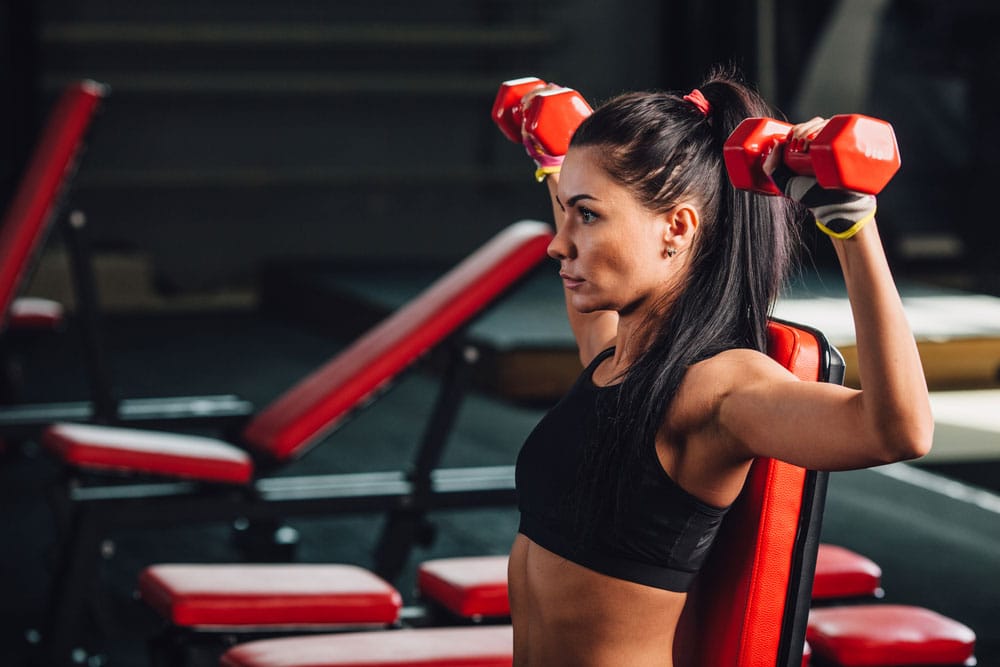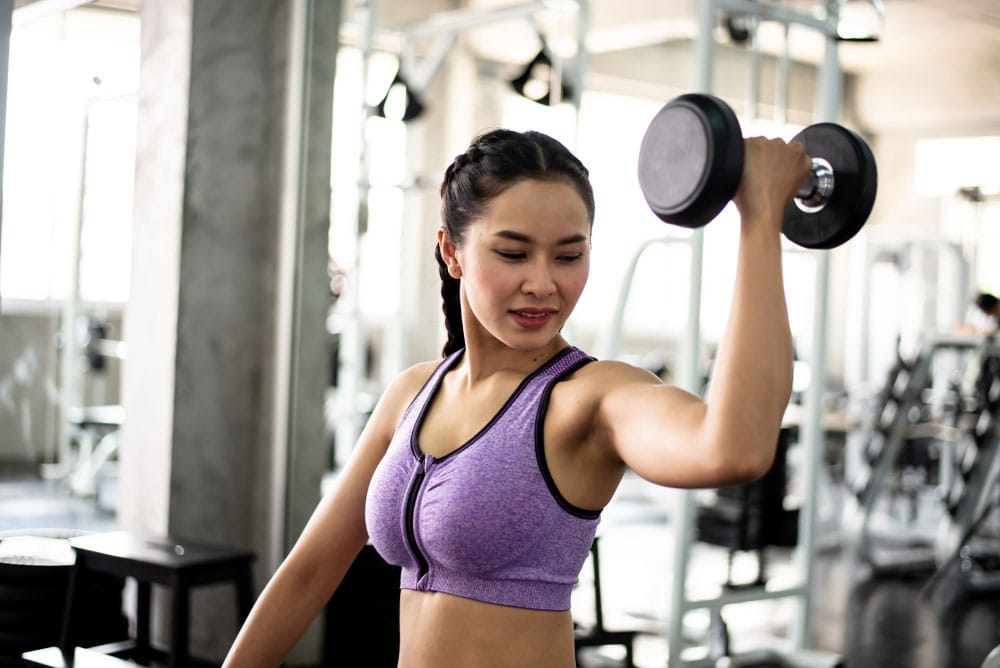Arnold Press vs. Shoulder Press: Best Moves for Big Shoulders
This guide will help you understand the differences, similarities, and benefits of the Arnold press vs. shoulder press.
It’s 2024 and your shoulder routine needs an upgrade.
Maybe you’ve analyzed the benefits of the military press vs. shoulder press, come up with some workarounds for your bad shoulder genetics or even performed a shoulder mobility test, but still, you’re looking for more.
If you’re serious about achieving the boulder shoulder aesthetic workouts of your dreams, then you’ve come to the right place.
Named after the man, the myth, the legend, Arnold Schwarzenegger himself, the Arnold press is an expansion of the traditional shoulder press that can give you some seriously big guns. Once beach season rolls around, you want to work towards looking like Arnold himself.
But does the Governator’s version reign supreme, or is the old faithful shoulder press the best go-to move to build a stronger upper half?
In a showdown of epic proportions, we’ll analyze the differences between an Arnold press vs. a shoulder press, learn which muscles they work and see which one is more beneficial for building big shoulders.
What is a Shoulder Press?

Before we get to know the Arnold variation, let’s look at the traditional shoulder press. One of the best moves for building a sculpted upper body with shoulders that dominate. This move involves a simple press-up of weight above your head.
Also known simply as a dumbbell overhead press, you can also perform a regular shoulder press with a barbell (barbell overhead press).
How to Shoulder Press
- Set-Up: Rack your dumbbells on the tops of your shoulders with your palms facing forward. Keep your wrists straight, palms engaged and forearms straight. Your dumbbells shouldn’t be sliding back or pulling your wrists out of alignment. If this happens, you may want to see if hand grippers work to improve your grip. Keep your feet planted shoulder-width apart and hold a firm stance. You may also wish to sit down on a weight bench for this move.
- Lift: Press your weights up and towards the ceiling, keeping your chest proud. Engage your abdominals to hold your posting, especially if you are standing. Press your dumbbells up and over your head to fully extend your arms. Don’t let the weights fall in front of or behind your body, but try to keep them in a straight line. Think about lining your biceps up next to your ears to keep your form.
- Reverse: Hold your dumbbells up in the air for a pause, then reverse the lift to bring your weights back down to your shoulders. Repeat.
- Reps: Continue for 3-4 sets of 8-12 reps with medium to heavy weight.
Shoulder Press Muscles Worked
The traditional shoulder press is an exceptional choice for strengthening and toning your shoulder muscles.
What muscles does a shoulder press work?
Deltoids
These large, triangle-shaped muscles cover your glenohumeral joints in the shoulders. Strong and developed deltoids help to give shoulders their rounded shape.
When you shoulder press, your deltoids help you to move your arms. They also keep your shoulders stable.
Some evidence indicates that shoulder pressing may be more effective than bench pressing or lateral raises for deltoid activation. In one study, the traditional shoulder press elicited higher muscular activation in the anterior and posterior (front and back) deltoids compared to lateral raises and bench presses.
The side deltoids were well-activated in both shoulder presses and lateral raises compared to the bench press.
For reference, here is some research into how different shoulder exercises affect deltoid activation.
Triceps
The main function of your triceps is to extend your elbows. When you shoulder press, your triceps engage to straighten your elbows as you press the weight up and over your head.
Chest
The main chest muscles are the pectoralis major, pectoralis minor and the serratus anterior. Informally, we refer to the chest muscles as your pecs.
The upper chest mainly acts as a stabilizer to your shoulder press, activating to help you hold your posture and maintain core activation during this exercise.
Trapezius
The trapezius muscles span from the base of your neck, across your shoulders and anchor to your mid-back. These muscles are responsible for most of your head and neck motions. When you nod “yes” or shake your head “no,” you engage the trapezius muscles.
Traps help with any kind of overhead lifting or pressing motion your body makes. When you lift your arms in a shoulder press, you recruit your traps.
What is an Arnold Press?

The Arnold press adds a wrist rotation to your traditional dumbbell shoulder press to hit all three of the deltoid muscles more effectively.
Arnold Schwarzenneger invented this move intending to activate all three heads of the deltoid muscle at the same time. The seven-time Mr. Olympia athlete found that he was not getting enough anterior (front) deltoid engagement during his shoulder presses.
So he decided to come up with a clever alternative.
In an Arnold press, you make a wraparound motion with your wrists, rotating them 180 degrees externally as you lift your weight up and internally on the way down.
Arnold Press Muscles Worked
The Arnold Press works all the muscles of a traditional shoulder press but puts more effort into the rotator cuff muscles.
Lifting less weight doesn’t allow for as much of the mechanical tension on your muscles to help them grow.
Benefits of Arnold Press
Deltoid Activation
Compared to a regular shoulder press, the Arnold press activates more of the anterior and lateral deltoids (front and side delts) but also works into the posterior deltoids (rear delts). Engaging all 3 deltoid muscle heads at the same time makes this a complex move that satisfies multiple purposes.
If you’re looking for an all-in-one exercise for big shoulders, the Arnold press is a fantastic way to balance out your upper body.
Because you are making a wraparound motion with your arms, this move works into the sides of your delts in a way that the traditional shoulder press doesn’t because of its straight up and down motion.
Excitement
For most lifters, the Arnold press feels like an exciting break from the monotony of the traditional shoulder press. With an extra step involving your wrist rotation, the Arnold press feels like a more complex alternative to a regular shoulder press,
Less Strain on the Rotator Cuff
The rotator cuff muscles, are particularly susceptible to getting hurt when you work your shoulder. The rotator cuff muscles are:
- Subscapularis
- Infraspinatus
- Teres minor
- Supraspinatus.
Here, you can learn more information about rotator cuff anatomy.
Contrary to what you might think, the Arnold press can be less aggravating than the shoulder press for your rotator cuff.
Why?
Arnold presses redirect most of the muscular work to your deltoid muscles. Because of this, the variation takes some effort out of your rotator cuff. With less work to do in an Arnold press vs. a shoulder press, your rotator cuff can get some rest if you suffer from injuries to the area.
Disadvantages of Arnold Press
Can’t Lift Heavy
An Arnold press is a more complicated move than a traditional shoulder press with more potential for injury if you overdo it.
Arnold presses require a higher degree of coordination. Unlike the straight up and down motion of a shoulder press, the added rotation of the Arnold press forced you to think about another step to add to your lifting routine.
Since it takes some extra effort, you may not be able to lift as heavy as you’re used to. This can reduce your ability to achieve a good rate of progressive overload.
If you’re hoping to put on muscle using shoulder presses to get “boulder shoulders,” then you need to be lifting heavy. Reducing the weight of your dumbbells for an Arnold press can inhibit your ability to make fast shoulder gains.
Shoulder Injury Risk
For those with shoulder injuries or issues, Arnold pressing can put a lot of stress on your joints. The twisting movement of the Arnold press may not agree with you if you have delicate shoulders.
If you want to mitigate risk of injuries or shoulder pain, the regular shoulder press may be the better of these shoulder press variations for you.
If you still prefer to Arnold press, make sure to use proper form and start with a lighter weight.
How to Do an Arnold Press
Now that you understand the differences between shoulder presses and Arnold presses, let’s learn how to Arnold press.
To start, let’s unpack the Arnold press.
To execute this move:
- Set-Up: Sit on a weight bench with your feet in a comfortable stance on the floor. You can also perform this move standing up. Keep your feet shoulder-width apart if you choose to stand.
- Equipment: Grab a dumbbell in each hand with an underhand grip. Start the move off by bending your elbows to bring your hands up to a bicep curl position with your weights hovering near your collarbones and your palms facing your body. This is your starting position.
- Press: Rotate your wrists outward while you simultaneously rotate your wrists outward while you start to press your dumbbells up and away from your chest. Keep lifting your weights until your arms extend overhead, twisting your wrists to flip your palms. Don’t lock out your elbows, but maintain muscular activation in the arms so they should be almost straightened. At the top of the movement, your palms should be rotated 180 degrees to face forward.
- Reverse: From the top of this movement, slowly lower your dumbbells and twist your wrists inward, in the opposite direction, so your palms are facing you at the bottom of the move.
- Reps: Repeat this pattern for 3-4 sets of 8-12 reps with medium-weight dumbbells.
Is the Arnold Press Better than the Shoulder Press?
There is no conclusive evidence to suggest that Arnold presses are overall better than traditional shoulder presses.
Both moves do a solid job of helping your shoulders to grow. That being said if you find it challenging to activate the deltoid muscles or if you want more simultaneous muscle activation, the Arnold press may be a better variation for you to try.
If you tend to get bored easily in the gym, the Arnold press can also be a better option to keep you mentally engaged.
On the other hand, if you like things clean and simple and you’re going for pure strength gains, lifting heavy may feel easier with the traditional shoulder press.
The Takeaway
If you want to hit all three deltoid muscles simultaneously, the Arnold press is one of the best overhead shoulder pressing exercises you can try.
The rotational aspect of this exercise helps you to engage the
References
Campos, Y. A. C., Vianna, J. M., Guimarães, M. P., Oliveira, J. L. D., Hernández-Mosqueira, C., da Silva, S. F., & Marchetti, P. H. (2020). Different Shoulder Exercises Affect the Activation of Deltoid Portions in Resistance-Trained Individuals. Journal of human kinetics, 75, 5–14. https://doi.org/10.2478/hukin-2020-0033
Luczak, J., Bosak, A., & Riemann, B. L. (2013). Shoulder Muscle Activation of Novice and Resistance Trained Women during Variations of Dumbbell Press Exercises. Journal of sports medicine (Hindawi Publishing Corporation), 2013, 612650. https://doi.org/10.1155/2013/612650
Maruvada S, Madrazo-Ibarra A, Varacallo M. Anatomy, Rotator Cuff. [Updated 2023 Mar 27]. In: StatPearls [Internet]. Treasure Island (FL): StatPearls Publishing; 2024 Jan-. Available from: https://www.ncbi.nlm.nih.gov/books/NBK441844/
May T, Garmel GM. Rotator Cuff Injury. [Updated 2023 Jun 26]. In: StatPearls [Internet]. Treasure Island (FL): StatPearls Publishing; 2024 Jan-. Available from: https://www.ncbi.nlm.nih.gov/books/NBK547664/
Peterson, M. D., Pistilli, E., Haff, G. G., Hoffman, E. P., & Gordon, P. M. (2011). Progression of volume load and muscular adaptation during resistance exercise. European journal of applied physiology, 111(6), 1063–1071. https://doi.org/10.1007/s00421-010-1735-9
Related articles


Get fit with Flex
Build muscle & lose weight fast for free.
Available on iPhone + Apple Watch





